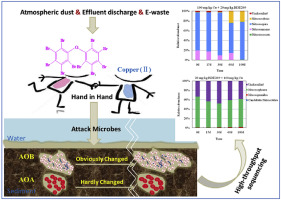当前位置:
X-MOL 学术
›
Chemosphere
›
论文详情
Our official English website, www.x-mol.net, welcomes your
feedback! (Note: you will need to create a separate account there.)
Response of ammonia oxidizing archaea and bacteria to decabromodiphenyl ether and copper contamination in river sediments
Chemosphere ( IF 8.1 ) Pub Date : 2017-10-12 , DOI: 10.1016/j.chemosphere.2017.10.067 Linqiong Wang , Yi Li , Lihua Niu , Wenlong Zhang , Huanjun Zhang , Longfei Wang , Peifang Wang
Chemosphere ( IF 8.1 ) Pub Date : 2017-10-12 , DOI: 10.1016/j.chemosphere.2017.10.067 Linqiong Wang , Yi Li , Lihua Niu , Wenlong Zhang , Huanjun Zhang , Longfei Wang , Peifang Wang

|
Ammonia oxidation plays a fundamental role in river nitrogen cycling ecosystems, which is normally governed by both ammonia oxidizing archaea (AOA) and ammonia oxidizing bacteria (AOB). Co-contamination of typical emerging pollutant Polybrominated diphenyl ethers (PBDEs) and heavy metal on AOA and AOB communities in river sediments remains unknown. In this study, multiple analytical tools, including high-throughput pyrosequencing and real-time quantitative PCR (qPCR), were used to reveal the ammonia monooxygenase (AMO) activity, subunit alpha (amoA) gene abundance, and community structures of AOA and AOB in river sediments. It was found that the inhibition of AMO activities was increased with the increase of decabromodiphenyl ether (BDE 209, 1–100 mg kg−1) and copper (Cu, 50–500 mg kg−1) concentrations. Moreover, the synergic effects of BDE 209 and Cu resulted in a higher AMO activity reduction than the individual pollutant BDE 209. The AOA amoA copy number declined by 75.9% and 83.2% and AOB amoA gene abundance declined 82.8% and 90.0% at 20 and 100 mg kg−1 BDE 209 with a 100 mg kg−1 Cu co-contamination, respectively. The pyrosequencing results showed that both AOB and AOA community structures were altered, with a higher change of AOB than that of AOA. The results demonstrated that the AOB microbial community may be better adapted to BDE 209 and Cu pollution, while AOA might possess a greater capacity for stress resistance. Our study provides a better understanding of the ecotoxicological effects of heavy metal and micropollutant combined exposure on AOA and AOB in river sediments.
中文翻译:

氨氧化古细菌和细菌对河流沉积物中十溴二苯醚和铜污染的响应
氨氧化在河流氮循环生态系统中起着基本作用,通常由氨氧化古细菌(AOA)和氨氧化细菌(AOB)共同控制。在河流沉积物中的AOA和AOB群落上典型的新兴污染物多溴联苯醚(PBDEs)和重金属的共污染仍然未知。在这项研究中,包括高通量焦磷酸测序和实时定量PCR(qPCR)在内的多种分析工具被用来揭示氨单加氧酶(AMO)的活性,亚基α(amoa)基因的丰度以及AOA和AOA的群落结构。河流沉积物中的AOB。发现随着十溴二苯醚(BDE 209,1–100 mg kg -1)和铜(Cu,50–500 mg kg)的增加,对AMO活性的抑制作用也增加了。-1)浓度。此外,BDE 209和Cu的协同作用导致AMO活性的降低要高于单个污染物BDE209。AOAamo A的拷贝数分别下降了75.9%和83.2%,AOB amo A基因的丰度分别下降了82.8%和90.0%。 20和100 mg kg -1 BDE 209与100 mg kg -1铜共同污染。焦磷酸测序结果表明,AOB和AOA的群落结构均发生了改变,AOB的变化高于AOA。结果表明,AOB微生物群落可能更好地适应BDE 209和Cu污染,而AOA可能具有更大的抗逆能力。我们的研究更好地了解了重金属和微量污染物联合暴露对河流沉积物中AOA和AOB的生态毒理作用。
更新日期:2017-10-12
中文翻译:

氨氧化古细菌和细菌对河流沉积物中十溴二苯醚和铜污染的响应
氨氧化在河流氮循环生态系统中起着基本作用,通常由氨氧化古细菌(AOA)和氨氧化细菌(AOB)共同控制。在河流沉积物中的AOA和AOB群落上典型的新兴污染物多溴联苯醚(PBDEs)和重金属的共污染仍然未知。在这项研究中,包括高通量焦磷酸测序和实时定量PCR(qPCR)在内的多种分析工具被用来揭示氨单加氧酶(AMO)的活性,亚基α(amoa)基因的丰度以及AOA和AOA的群落结构。河流沉积物中的AOB。发现随着十溴二苯醚(BDE 209,1–100 mg kg -1)和铜(Cu,50–500 mg kg)的增加,对AMO活性的抑制作用也增加了。-1)浓度。此外,BDE 209和Cu的协同作用导致AMO活性的降低要高于单个污染物BDE209。AOAamo A的拷贝数分别下降了75.9%和83.2%,AOB amo A基因的丰度分别下降了82.8%和90.0%。 20和100 mg kg -1 BDE 209与100 mg kg -1铜共同污染。焦磷酸测序结果表明,AOB和AOA的群落结构均发生了改变,AOB的变化高于AOA。结果表明,AOB微生物群落可能更好地适应BDE 209和Cu污染,而AOA可能具有更大的抗逆能力。我们的研究更好地了解了重金属和微量污染物联合暴露对河流沉积物中AOA和AOB的生态毒理作用。





















































 京公网安备 11010802027423号
京公网安备 11010802027423号